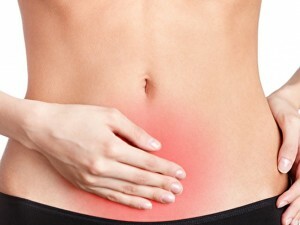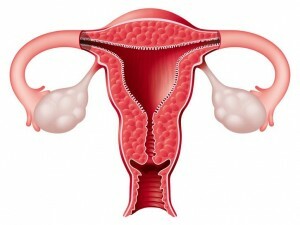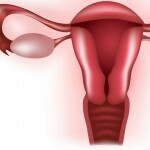Climax changes a lot in the female body. Among the new sensations and features, most are natural, some can lead to big health problems. There are also such changes that may be the norm, but in the long term appear dangerous. One is atresia of the cervical canal in postmenopausal women. What happens to this part of the reproductive system, and how to assess the changes?
How and why does the permeability of the cervical canal in menopause change
 Cervical canal is a narrow enough space insidecervix. If necessary, he can stretch out, but the need for this arises only in the reproductive age.
Cervical canal is a narrow enough space insidecervix. If necessary, he can stretch out, but the need for this arises only in the reproductive age.
In menopause, this narrow path from the vagina to the sterile uterus becomes smaller, both in length and width. This is caused by the influence of the hormonal disorder, inevitable in this period. Attenuation of ovarian activity, that is, a decrease in the production of estrogens and gestagens, makes FSH volume increase, as well as insensitivity of the reproductive organs, mandatory. If before their development was cyclical, now it turns into irreversible. All sexual organs become smaller in size, the thickness of their constituent layers is reduced, functions are changed.
The cervical canal is lined with epithelial tissue, also very dependent on the level of sex hormones. With menopause, it reduces the production of mucus, it becomes thinner.

Is it normal for
One of the mandatory methods of examination is the sampling and cytological analysis of cells from the surface of the cervix and from the cervical canal. And if the first is easy enough in any case, the second one will be impossible with a closed area of the uterus.
When a woman is well, she will have a regular ultrasound and gynecological examination. And if pathologies are not found, there is no need to "print out" the cervical channel. After all, the hardware technique reveals all the changes in the endometrium, the most important of which is its thickness. If the value of this indicator is too high, the experts have reasons to be worried, to conduct a further examination, in which access to the uterus should be opened. Then the bougie is carried out, that is, the operation to cut the fused tissues.
Pathological causes of complete stenosis
 Cervical canal atresia in menopause can be provoked and different from natural hormonal disorders by causes. Just dangerous it happens at the initial stage of menopause, when the menstrual function is not yet completed. After all, the allocation, even if the endometrium is updated every 3 or 6 months, should be withdrawn.
Cervical canal atresia in menopause can be provoked and different from natural hormonal disorders by causes. Just dangerous it happens at the initial stage of menopause, when the menstrual function is not yet completed. After all, the allocation, even if the endometrium is updated every 3 or 6 months, should be withdrawn.
Increasing the way of their exit leads to stagnation of mucus in the cavity, pelting it into the fallopian tubes, development of inflammation in them and the organ itself. This manifests itself with abdominal pain, fever, and general intoxication.
A similar problem can occur in postmenopause, when the menstrual function is completed. Serous fluid can form in the uterus, which, unable to get out, provokes the already mentioned problems. It is also found during ultrasound. The appearance of serosymmetry causes such characteristic for the age of climax disease:
- Cervicitis. The canal infection occurs when the disease is neglected, and the inflammation itself is provoked by a decrease in estrogens, atrophic processes in the vaginal mucosa and neck, characteristic of postmenopause;
- Polyps. The first appearance of a benign neoplasm is also possible with menopause, as one of the many triggers of it is a hormonal malfunction and an inflammatory process;
- Endometrial hyperplasia. Menopause with its hormonal disorders can lead to abnormal thickening of the mucous uterus instead of natural atrophy. The division of endometrial cells, in turn, can provoke a fusion of tissues at the outlet to the vagina;
- Malignant tumors. Many of them in menopause get the best conditions for the onset, especially carcinomas. If the tumor is located in the ovary, it can disrupt the functionality of the cervical canal. This is all the more likely when endometrial cancer is present.
Cervical canal atresia occurs in post-menopause not in all cases of these diseases. But if it is found out because of discomfort and pain, ultrasound shows an increase in the uterus, possibly finding one of the ailments.
 We recommend reading an article on the expansion of the cervical canal in postmenopausal women. You will learn about the causes of the change in menopause and consequences.
We recommend reading an article on the expansion of the cervical canal in postmenopausal women. You will learn about the causes of the change in menopause and consequences.
Is it possible to prevent infection of access to the uterus
 ? All of the listed gynecological diseases, as well as the very entry into the age of menopause, do not necessarily mean complete stenosis of the cervical canal. In addition to them, it can be provoked by:
? All of the listed gynecological diseases, as well as the very entry into the age of menopause, do not necessarily mean complete stenosis of the cervical canal. In addition to them, it can be provoked by:
- Previously transmitted infections, including sexually transmitted infections. Bacteria are subjected to mucosa forced and unnatural changes, which may find response in the future;
- Operations on the uterus, ovaries. This curettage of a different kind, abortion, cesarean section. They contribute to the appearance of adhesions in the uterine cavity, which develop with the climacteric hormonal disorder, growing together;
- Stresses. The factor is especially relevant for the menopause period, since it is one of the manifestations of its severe course;
- Genetic features of development of the reproductive system;
- Radiation therapy.
On most of these factors a woman has the possibility of influence. If you follow gynecological health from a young age, to deal with good specialists, you can avoid many negative moments of menopause, including infection of the canal.
Directly in menopause it is easier to neutralize one more reason for complete stenosis - atrophic processes in the vaginal mucosa. After all, it is directly related to the cervical canal. If you do not tolerate discomfort and dryness, and use hormonal gels and suppositories restoring the structure of the mucous, the risk of inflammation and infections decreases. That is, several causes of complete stenosis are eliminated.
Cervical canal atresia is not a post-menopausal verdict. The very likelihood of its appearance, especially existence - an extra reason to carefully monitor your health, strive to ease the climacteric period.

